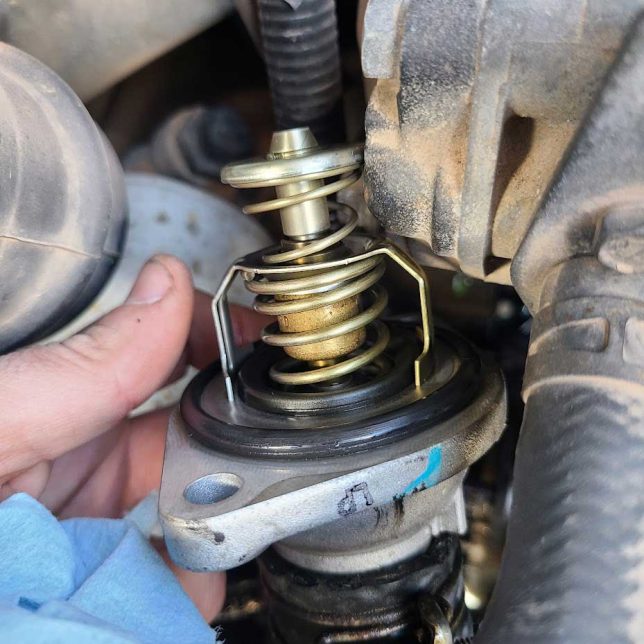Well, if you’ve ever wondered what a 1992 Mitsubishi Pajero radiator looks like, behold. You may be wondering: why is Andy here with a Pajero radiator? Well, wonder no more. Here’s the scoop.
A few months back, I was headed south on Interstate 5 and was on a long but mild incline. I happened to look at my gauges only to see the water temperature was above where it usually is at the halfway mark. Well, that’s strange. I’d driven all the way down to the California-Mexico border and back this autumn with no issue. There is one thing I do know: the radiator has always had lots of rust in it. The rust likely came from the previous Mitsubishi 4D56 block (it now has a new Hyundai D4BF), as the radiator itself is copper and brass (and doesn’t rust). But, if you used tap water to dilute your coolant, there’s a chance you could get corrosion buildup over time. The aftermarket JDM radiator cap that came with the Pajero was always rusty and gross. First step? Replace it.
With the new cap on, as well as a new hose to the overflow jug, I went for a test drive. Seems OK. A few months later, I went four-wheeling with my friend, Coy, from The Off-Road Podcast. As I approached a long, slow grade on Highway 6, once again, the temperature started to climb. It was fine most of the day off-road, sans — you guessed it — long slow grades. Not long thereafter I did a coolant flush. There was some debris that came out, but not loads of it.
After completing the flush (which includes a messy removal of the block drain plug), I took it for a test drive. A long test drive that included hills and grades. No issue. Problem solved?
Driving To Easter Jeep Safari
Since it appears my coolant flush solved the problem, we drove the Pajero, aka the Ralli Tractor, to Easter Jeep Safari. If it could make it up the 6% grade at Cabbage Hill outside of Pendleton, OR, then we knew it’d be fine. If it started to heat up, we’d go home and get another rig. I kept an eagle eye on the temp gauge as we ascended the steep stretch. Surprisingly — and triumphantly — the gauge stayed normal. Cue “We Are The Champions.” About 1,000 miles later, we were in Moab.

Day one of Easter Jeep Safari had us in the Whitewash Sand Dunes. If it was going to overheat, this place would do it. There were steep climbs up big dunes, a scenario sure to test the cooling system. Despite this challenge, the temp stayed in check. I’m feeling great!
After a day of wheeling, we said our goodbyes to other people on the run, and got back onto Highway 191 South to head back to town. About halfway back, I happened to glance at my gauges and … shit: the temp gauge was 3/4 of the way up. Damn it!
Quick Fixes?

As the owner of three JDM turbodiesel Mitsubishis, I know to bring certain spares. I brought a spare thermostat just in case of something like this. I skipped the next day’s trail run to swap out the part in the hotel parking lot (of course). In went the brand-new part and I went for a drive after burping the system. I went up the long, steep grade on HWY 191 North with no issue. Well, I guess it was a bad thermostat. I stopped at the local Maverick for a celebratory energy drink. But, being skeptical, I thought I should test it again. There was an exceptionally strong south wind this day, so I pointed the Pajero at HWY 191 south, dead into 50 MPH gusts. Slowly, the temp gauge started to creep up. Again.
After testing it a few more times, it was apparent that the thermostat was not the issue. My lower radiator hose was cold to the touch, even when the top hose and top tank were scalding hot. This radiator was not flowing well.
Thankfully, I was able to put the Pajero on a Warn Industries trailer, and drive one of their company Jeeps back home (FYI, I worked at Warn at the time, they don’t just do loaners).
Diagnosing A Bad Radiator And What To Do About It
The Pajero’s radiator is brass and copper and therefore can be rebuilt. Unfortunately, nothing directly cross-references with this part in North America, so replacements aren’t readily available. There happens to be one radiator shop in Portland left that’ll actually rebuild rads. I called them up. It would be $45 to have it flow-tested, so out came the radiator and I dropped it off at the shop. The next day, they called and said it was 20% blocked up and very rusty inside. I had two options: the radiator could be reconditioned by having the tanks desoldered and the core soaked in chemicals, rodded out, and put back together. Or, I could have the entire center re-cored. A refurb was about $550; a re-core about $840.
Simultaneously, I found a cheap radiator from Milners Off Road in the United Kingdom. It didn’t have a brand name, but said it’d fit. I figured, hey if it lasts a few years, why not? I ordered it for what I thought was $275 USD shipped to Oregon. However, the next day, I was informed it’d be another $100 USD due to its large size. Well, now we’re at $375, I’m not 100% sure it’ll fit, I can’t send it back if it doesn’t, and it’s going to be an inferior product vs. the OEM all-metal unit. Well, buy once, cry once. I’ve opted for the re-core.
PS: Fast Overseas Shipping and JDM Parts
By the way, I also ordered new upper and lower radiator hoses from PartSouq.com, which is a fantastic site. Yes, you have to pay more for shipping than many places, but they always do a good job. And, incomprehensibly, they were able to get me the radiator hoses in five business days from the UAE … as in the United Arab Emirates. I’ve said it once, and I’ll say it again: I cannot send my mother a postcard from Oregon to Wisconsin in five days. I don’t know how they do it.
So at the moment, I’m waiting on my re-cored radiator to get the Ralli Tractor back on the road and trail. I’m very much hoping that the radiator is the culprit here. If not, I’m not sure what is the issue. The water pump isn’t leaky (and only has 10,000 miles on it). So, I’m crossing my fingers that my costly radiator redo will fix the cooling issues.

Andy Lilienthal is an award-winning writer and has written professionally since 1999. He has over 13 years in the automotive aftermarket working at companies including Warn Industries, Bushwacker, and Lund International. Editorial works include writing and photography for off-road print magazines, to new-car reviews online. He’s a photographer with images in multiple magazines, blog sites, and The New York Times.


Leave a Reply